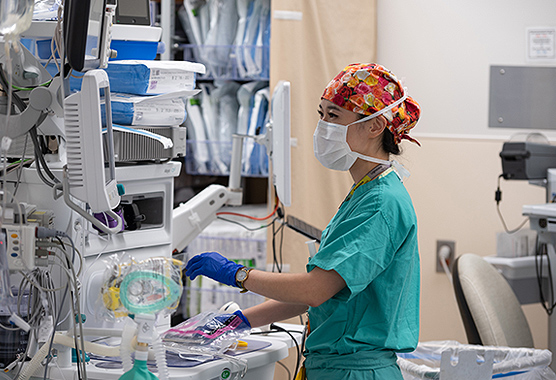Regional anesthesia plays a pivotal role in modern surgical practice, providing targeted pain relief and improving patient outcomes. Unlike general anesthesia, which induces unconsciousness, regional anesthesia blocks pain sensations in specific regions of the body, allowing patients to remain conscious or sedated while the surgical procedure is performed. This method is widely used in various types of surgeries due to its effectiveness in pain management and reduced systemic side effects. In this article, we explore the different types of regional anesthesia, their benefits, potential risks, and their application in surgical settings.

Types of Regional Anesthesia Used in Surgery
Epidural Anesthesia for Major Surgeries
Epidural anesthesia is one of the most commonly used regional anesthetic techniques, particularly for major surgeries such as abdominal, thoracic, and orthopedic procedures. The procedure involves injecting anesthetic agents into the epidural space, located around the spinal cord, to block pain signals from the lower body.
Procedure:
- A catheter is placed in the epidural space of the spine, typically at the lower back.
- Local anesthetics such as bupivacaine, ropivacaine, or lidocaine are administered, often in combination with opioids for enhanced analgesia.
- Continuous infusion of anesthetics through the catheter can provide prolonged pain relief during and after the surgery.
Benefits:
- Effective for surgeries involving large areas, especially the abdomen, chest, or lower limbs.
- Reduced reliance on systemic opioids, decreasing the risk of opioid-related side effects.
- Provides long-lasting pain relief, aiding in postoperative recovery.
Risks:
- Possible side effects include hypotension (low blood pressure), motor weakness, and urinary retention.
- Requires careful monitoring to avoid complications, such as catheter displacement or infection.
Spinal Anesthesia for Lower Body Surgeries
Spinal anesthesia is often used for surgeries involving the lower abdomen, pelvis, or legs. Unlike epidural anesthesia, which delivers medications through a catheter, spinal anesthesia involves a single injection of anesthetic agents directly into the subarachnoid space surrounding the spinal cord.
Procedure:
- A needle is inserted between the vertebrae in the lumbar region to inject anesthetic agents into the subarachnoid space.
- Local anesthetics like bupivacaine or hyperbaric lidocaine are commonly used to block pain and motor function in the lower body.
- The effects are rapid and typically last for a few hours, depending on the type of surgery.
Benefits:
- Provides excellent pain relief for surgeries involving the lower abdomen, pelvis, and legs.
- Faster onset compared to epidural anesthesia, with patients often experiencing numbness within minutes of injection.
- Lower doses of medication required, reducing the risk of systemic side effects.
Risks:
- Like epidural anesthesia, spinal anesthesia can cause hypotension, nausea, and vomiting.
- The risk of spinal headaches, though rare, can occur if the dural membrane is punctured during the procedure.
Peripheral Nerve Blocks for Targeted Pain Relief
Peripheral nerve blocks are used to anesthetize specific areas of the body by targeting the nerves that supply sensation to that area. This technique is commonly used for surgeries involving the limbs, such as shoulder, knee, or hand surgeries.
Procedure:
- A local anesthetic is injected near the targeted nerve, either by palpating anatomical landmarks or using ultrasound guidance.
- Common agents include lidocaine, bupivacaine, or ropivacaine, which block the transmission of pain signals from the surgical site.
- The block can be performed as a single injection or with a catheter for continuous infusion.
Benefits:
- Ideal for localized pain management, particularly for orthopedic or soft tissue surgeries.
- Offers excellent pain control with minimal systemic effects.
- Allows for faster recovery and mobilization after surgery, especially in limb surgeries.
Risks:
- Potential complications include nerve injury, infection, or hematoma formation.
- Requires accurate placement of the needle to avoid injuring adjacent structures.
Continuous Regional Anesthesia for Extended Pain Relief
For surgeries that involve longer recovery times or more extensive procedures, continuous regional anesthesia can be used to provide sustained pain relief. This technique involves the use of a catheter inserted into the epidural space or near specific nerves, allowing for a continuous infusion of anesthetic agents.
Procedure:
- A catheter is inserted either into the epidural space or close to the nerve plexus, and local anesthetics are administered through an infusion pump.
- The medication can be continuously adjusted to provide optimal pain relief, reducing the need for oral or intravenous analgesics.
Benefits:
- Provides continuous and long-lasting pain control, particularly useful for major surgeries.
- Reduces the overall consumption of systemic opioids, decreasing the risk of side effects like nausea, vomiting, and constipation.
- Allows for more comfortable recovery and faster mobilization.
Risks:
- Requires careful monitoring to adjust the infusion rate and prevent overdose.
- May cause motor block or other side effects if the medication is not properly titrated.
Benefits of Regional Anesthesia for Surgery
Targeted Pain Management
One of the primary advantages of regional anesthesia is its ability to provide targeted pain relief, focusing only on the surgical area without affecting the entire body. This ensures that patients remain conscious and alert while avoiding the systemic side effects commonly associated with general anesthesia.
Reduced Need for Systemic Opioids
By effectively managing pain with regional blocks, the need for opioid medications is significantly reduced. This decrease in opioid consumption minimizes the risk of opioid-related side effects, such as nausea, sedation, and long-term dependence.
Faster Recovery and Improved Mobility
Regional anesthesia allows for more rapid recovery following surgery. Patients typically experience less postoperative pain, leading to quicker mobilization and reduced complications, such as deep vein thrombosis (DVT) or pneumonia, which are often linked to prolonged immobility.
Enhanced Patient Satisfaction
The reduction in pain and the ability to maintain some level of awareness during surgery generally result in higher levels of patient satisfaction. Regional anesthesia offers a less invasive and more comfortable alternative to general anesthesia, especially for patients with underlying medical conditions that may make general anesthesia riskier.
Risks and Complications of Regional Anesthesia
Hematoma and Infection
Any invasive procedure carries inherent risks, and regional anesthesia is no exception. Epidural and spinal anesthesia, in particular, involve the insertion of needles or catheters near the spinal cord, which can lead to complications such as hematoma (blood collection) or infection at the insertion site.
Nerve Injury
Although rare, nerve damage can occur during the placement of regional anesthesia blocks, particularly if the needle is incorrectly positioned or if the procedure is performed without adequate guidance. Peripheral nerve blocks can carry the risk of transient or permanent nerve injury.
Hypotension and Bradycardia
Both epidural and spinal anesthesia can result in hypotension (low blood pressure) or bradycardia (slow heart rate), which can be concerning, especially in patients who are already at risk of cardiovascular complications. Close monitoring is required to prevent and manage these effects.
Regional anesthesia for surgery offers numerous benefits, including effective pain control, reduced reliance on opioids, and faster recovery times. By using targeted techniques such as epidural, spinal, and peripheral nerve blocks, healthcare providers can ensure that patients experience optimal pain management with fewer side effects. While there are risks associated with these techniques, they are generally outweighed by the advantages they offer in terms of pain relief and recovery. As technology advances, the safety and precision of regional anesthesia continue to improve, making it an invaluable tool in modern surgical practice.

